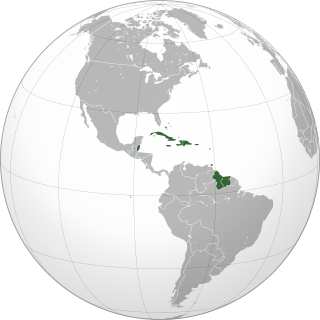
The West Indies are a subregion of North America, surrounded by the North Atlantic Ocean and the Caribbean Sea that includes 13 independent island countries and 18 dependencies and other territories in three major archipelagos: the Greater Antilles, the Lesser Antilles, and the Lucayan Archipelago.

The Caribbean is a region of the Americas that comprises the Caribbean Sea, its surrounding coasts, and its islands. The region lies southeast of the Gulf of Mexico and of the North American mainland, east of Central America, and north of South America.

Arca imbricata, or the mossy ark clam, is a clam in the family Arcidae. It can be found along the Atlantic coast of North America, ranging from North Carolina to the West Indies, Brazil, and Bermuda.

Anadara transversa, or the transverse ark clam, is a clam in the family Arcidae. It can be found along the Atlantic coast of North America, ranging from Massachusetts to Texas, including the West Indies.

Brachidontes exustus, or the scorched mussel, is a species of bivalve mollusc in the family Mytilidae. It can be found along the Atlantic coast of North America, ranging from Cape Hatteras to the West Indies and Brazil.

Ischadium is a monotypic genus of mussels in the family Mytilidae. The sole species is Ischadium recurvum, known as the "hooked mussel" or "bent mussel". It can be found along the Atlantic coast of North America, ranging from Cape Cod to the West Indies. They are often found growing on Eastern oysters, either intertidal or subtidal. They also attach to other hard substrates, including artificial reefs and dead shells of brackish water clams, Rangia cuneata.

Botula fusca, or the cinnamon mussel, is a species of bivalve mollusc in the family Mytilidae. It can be found along the Atlantic coast of North America, ranging from North Carolina to the West Indies and Bermuda.
Lithophaga nigra, or the black date mussel, is a species of bivalve mollusc in the family Mytilidae. It can be found along the Atlantic coast of North America, ranging from southern Florida to the West Indies.

Atrina serrata, or saw-toothed pen shell, is a species of bivalve mollusc in the family Pinnidae. It can be found along the Atlantic coast of North America, ranging from North Carolina to Texas and the West Indies.

Lima lima, or the spiny fileclam, is a species of bivalve mollusc in the family Limidae.

Plicatula gibbosa, or the Atlantic kitten's paw, is a species of bivalve mollusc in the family Plicatulidae. It can be found along the Atlantic coast of North America, ranging from North Carolina to the West Indies.
Dendostrea frons, the frond oyster, is a species of bivalve mollusc in the family Ostreidae.
The sponge oyster, Cryptostrea permollis, is a species of bivalve mollusc in the family Ostreidae. It can be found along the Atlantic Coast of North America, ranging from North Carolina to the West Indies.
Diplodonta punctata, or the Atlantic diplodon, is a species of bivalve mollusc in the family Ungulinidae. It can be found along the Atlantic coast of North America, ranging from North Carolina to the West Indies and Bermuda.
Chama congregata, or the corrugated jewel box clam, is a species of bivalve mollusc in the family Chamidae. It can be found along the Atlantic coast of North America, ranging from North Carolina to the West Indies and Bermuda.

Chama macerophylla, or the leafy jewel box clam, is a species of bivalve mollusc in the family Chamidae. It can be found along the Atlantic coast of North America, ranging from North Carolina to the West Indies.
Trachycardium muricatum, the yellow cockle, is a species of bivalve mollusc in the family Cardiidae. It can be found along the Atlantic coast of North America, ranging from North Carolina to the West Indies and Brazil.
Americardia media, the Atlantic strawberry cockle, is a species of saltwater clam, a marine bivalve mollusc in the family Cardiidae, the cockles. This species can be found along the Atlantic coast of North America, from Cape Hatteras to the West Indies.
Dosinia concentrica, common name the West Indian dosinia, is a species of saltwater clam, a marine bivalve mollusc in the family Veneridae. This species is found in Caribbean waters, ranging from the West Indies to Brazil.










